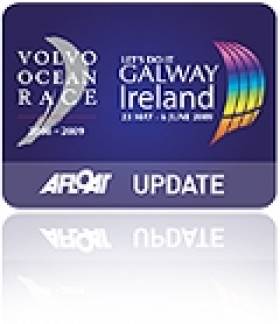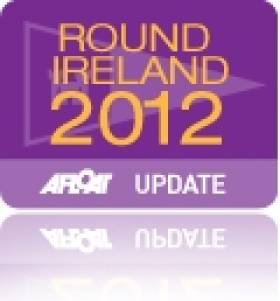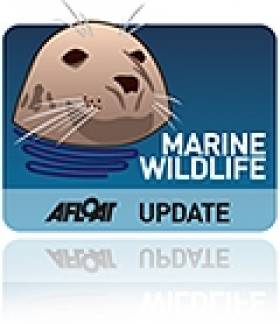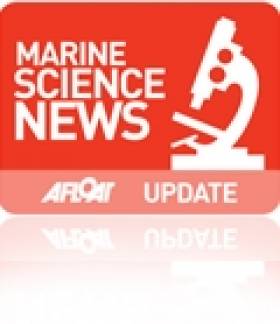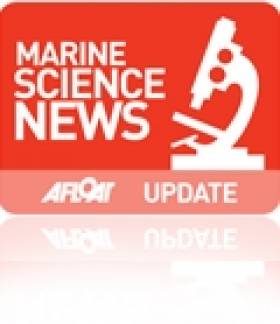Displaying items by tag: NUI Galway
#VOLVO OCEAN RACE - It has been revealed that a new coastal radar system developed at NUI Galway was instrumental to the success of the PUMA team in the in-port races at the recent Volvo Ocean Race finale.
The radar system, which measures currents and waves throughout Galway Bay on the hour, is run by Dr Mike Hartnett’s research group in the newly launched Ryan Institute at NUI Galway.
The sophisticated system is normally used for advanced marine research, but PUMA Ocean Racing performance coach Robert Hopkins Jr contacted the researchers to see if their radar data could be used by his crew to get the edge on the CAMPER team, with which they were tied on points.
Maps of the currents in the bay over the past month were made available to PUMA and Dr Hartnett advised team on their sailing strategy for the important race.
PUMA went on to win in great style and win the series by a one-point margin. The win also marked PUMA’s first trip to the top of the podium for an in-port race in this round of the Volvo Ocean Race.
PUMA finished on the podium in nine of the 10 in-port races, collecting 45 total points to win the overall In-Port Race Series.
Hopkins was delighted with the result. “Currents in Galway Bay were a big factor in the in-port race, where tides, wind and river outflow make it all very complicated," he said. "To prepare for the race, we looked for surface current patterns in hundreds hours of data from the NUI Galway radar, took on-the-water readings before the start, and data from Mar Mostro’s own Doppler velocity log supplied by Nortek AS. It worked and we won the race.”
The NUI Galway radar data will soon be available online to the public, hopefully helping local sailors to improve their performance.
Dr Hartnett acknowledged the assistance provided by two local businessmen in enabling this advanced technology.
“The Spiddal radar site is sending its data back to the computers at NUI Galway via the broadband service of An Crúiscín Lán, thanks to the permission of owner John Foy.
"Similarly, Liam Twomey, general manager of the National Aquarium of Ireland, Salthill, provided access to their broadband to courier the Mutton Island radar data back to NUI Galway.”
#roundireland – The countdown has begun for Sunday's Round Ireland Yacht Race where NUI Galway is supporting the first ever university-backed entry into the 700-mile race. Ten NUI Galway students and graduates will be on the start line in Wicklow this Sunday at 12 noon.
The race is a non-stop circumnavigation of Ireland by sea and will take anything from anything from four to six days. The NUI Galway crew is one of the youngest teams to ever compete in the event. Sailing together in the NUI Galway sailing club over the past few years has built up the trust and camaraderie which they will rely on during the race. The team have loaned a 38-ft racing yacht for the race.
The past few months have been very busy for the NUI Galway crew says skipper Cathal Clarke: "We have been following a tough training plan, attending safety courses and getting professional coaching. We recently competed in our first offshore race as a crew across the Irish Sea from Wales to Wicklow and were very happy with a second place result. The aims of this campaign are high, with a lot of experienced sailors on board; we will certainly be looking for good results."
Pat Morgan, Vice-President for the Student Experience at NUI Galway, said: "The determination and drive of this crew is to be admired, especially given that they are one of the youngest crews to participate in the race. They have worked very hard and displayed incredible determination and dedication over recent months in their preparation for the race. The University actively promotes leadership and team building skills and is delighted to support this crew to further develop these attributes as they compete in the Round Ireland Race. We wish them every success."
Second Fin Whale Stranding for Sligo
#MARINE WILDLIFE - Sligo County Council is considering its options for disposal after the county's second whale stranding of the winter, when a 60ft male fin whale was beached at Agharrow.
A spokesperson told the Sligo Champion that the whale was in an area known locally as Staid Abbey, lying on a smooth rock ledge that slopes down towards the sea, and is a difficult point to access - particularly in the present stormy conditions.
As previously reported on Afloat.ie, a whale carcass was washed up at the end of last month not far from Agharrow at Raughley. The Irish Whale and Dolphin Group (IWDG) has confirmed that this was the first validated stranding recorded of a fin whale in Co Sligo.
That whale had its flesh removed for fertiliser, while its bones were studied by PhD students from NUI Galway ahead of being buried in a nearby field to allow for the natural decomposition of remaining flesh before future preservation.
Record-Setting SCUBA Diver is Ireland's First Professor of Midwifery
#DIVING - A Guinness World Record holding SCUBA diver has been appointed as Ireland's first ever Professor of Midwifery, the Galway Advertiser reports.
Prof Declan Devine, who is a leading seararcher and scholar in the field, will take up the role at NUI Galway's School of Nursing and Midwifery.
His expertise in childcare goes in tandem with his efforts to raise funds for the care of children with serious illnesses. He serves as director of West of Ireland children's cancer charity Hand in Hand.
Prof Devine has also combined his charitable activities with his passion for SCUBA diving, raising more than €35,000 in 2009 when he set the Guinness World Record for the longest open saltwater SCUBA dive in cold water.
The Galway Advertiser has more on the story HERE.
New Radar System Could Improve Coastal Forecasts
A new radar system in Galway could help predict extreme weather events more accurately, The Irish Times reports.
Scientists at NUI Galway's Ryan Institute, in collaboration with the IBM Smarter Cities Technology Centre in Dublin, have installed the system on the shoreline in Galway Bay.
The system - the first of its kind in North Atlantic Europe - consists of two antennae, on Mutton Island and Spiddal, which scan the surface of the bay every half hour.
It then sends high-resolutions maps of surface currents and details of wave height and direction directly to the scientists' base at the NUIG campus.
The data is used, along with meteorological data, to develop models for forecasing marine conditions from tidal currents to storm surges - common on the challenging coastline around Galway Bay and the Aran Islands.
Moreover, the system is set to benefit the local community and beyond as the data, when completed, will be made freely available.
Silicon Republic says that the Galway Bay Coastal Observing System (GalCOS) could be used by sailors, fishermen and tourists to more accurately assess conditions in the area.
It could also be of use to local authorities in terms of providing details on the best time to release effluent while minimising environmental damage.
“This type of predictive modelling is critical to our Smarter Cities agenda," said IBM's Dr Lisa Amini, "and the findings can be widely applied to protect coastal cities and their environments."
Scientists Set to Show Off in Salthill
Hundreds of experts will be showcasing their work in marine science, weather and astronomy in Galway next Friday 23 September, the Galway Advertiser reports.
The special family-oriented Sea2Sky event - organised by NUI Galway in tandem with the Marine Institute and Galway Atlantaquaria - aims to educate the public about the wonders around us, from Ireland's marine wildlife and habitats to the stars and solar system.
The two main venues at Galway Atlantaquaria and Leisureland in Salthill will host various scientific demonstrations on the day, while the promenade between the two will be lined with amateur astronomers and their telescopes.
One of the highlights is sure to be the chance to see the remote submarine used by scientists to explore hydrothermal vents in the north Atlantic this summer.
The full programme of events is abailable at www.sea2sky.ie.
Irish Lead Mission to Find New Life on the Ocean Floor
An Irish-led marine research mission has set off to discover strange new lifeforms that inhabit the deepest parts of our oceans.
In collaboration with scientists from the UK’s National Oceanography Centre, the team sailed from Galway earlier this week bound for the Mid-Atlantic Ridge to investigate life at 3,000m below the surface of the sea.
Using a remotely operated vehicle (ROV) they will explore for the first time the 45o North MAR hydrothermal vent field, where vents spew mineral-rich seawater heated to boiling point in the earth’s crust. These are home to a rich variety of marine life that thrives in complete darkness on bacteria fed by chemicals.
Patrick Collins from NUI Galway’s Ryan Institute will lead Ireland's marine biological team investigating this unique ecosystem, which could tell us not only about how life might have evolved on other planets, but may also be a rich source of new biochemical processes with valuable medical and industrial applications.
"There is potential here to put Ireland on the global map as a serious player in deep sea science," said Collins. "This is all the more timely with the exploitation of deep sea and hydrothermal vents for precious metals and rare earth minerals now a reality.”
The mission carries geochemists, marine biologists, marine geologists, marine geneticists and technicians from Ireland and the UK as well as a three-person TV crew from National Geographic.
They will spend 25 days at sea and will be posting a regular blog on scientistsatsea.blogspot.com.
Explorers Team Goes Out of the Deep and into Space for Science Week
The Explorers Education Programme run by Galway Atlantaquaria with the support of the Marine Institute is emerging out of the deep blue sea and into space to celebrate the launch of National Science Week 2010. 'Our Place in Space' is the theme for this years Science Week event and the aquarium have organised a Family Fun Day on Sunday 7th November from 12.00 noon. We're offering a special price on the day of €12.00 for one adult and one child to include all activities.
This annual event at the aquarium will include interactive displays and talks from the Galway Astronomy Club and the Dept. of Physics & Astronomy at NUI Galway, Space Invaders and Pac Man games, Face Painting, Cartoon Art lessons for Aliens by the Marine Institute and a display of Ireland's very own Alien Species! A host of fun activities for all the family with Galaxy Art & Crafts and Amazing Space Science Experiments is organised. The event will be opened by Mayor of Galway, Cllr. Michael Crowe.
In a run up to the event, Galway Atlantaquaria is calling on primary school children to create an Alien Sea creature to celebrate Science Week 2010. Children are invited to use their own imagination to create their Alien Sea Creature works of art using discarded or reused materials. Age category prizes on offer and all entries will go on display at the aquarium. Remember all finished art work must be at the aquarium by Thursday 4th November and don't forget to include your name, age and school to your entry.
Science Week 2010 aims to raise awareness of the space industry in Ireland, with a wide range of activities taking place which will look at the latest happenings in astronomy and space exploration. For more information see details on the Galway Atlantaquarias website or contact 091 585100 or email [email protected]


























